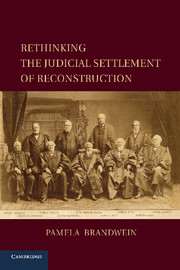Book contents
- Frontmatter
- Contents
- Acknowledgments
- 1 Abandoned Blacks?
- 2 The Emergence of the Concept of State Neglect, 1867–1873
- 3 The Civil/Social Distinction
- 4 The Birth of State Action Doctrine, 1874–1876
- 5 A Surviving Sectional Context, 1876–1891
- 6 The Civil Rights Cases and the Language of State Neglect
- 7 Definitive Judicial Abandonment, 1896–1906
- 8 Twentieth-Century Receptions
- 9 Conclusion
- Bibliography
- Index
7 - Definitive Judicial Abandonment, 1896–1906
Published online by Cambridge University Press: 03 May 2011
- Frontmatter
- Contents
- Acknowledgments
- 1 Abandoned Blacks?
- 2 The Emergence of the Concept of State Neglect, 1867–1873
- 3 The Civil/Social Distinction
- 4 The Birth of State Action Doctrine, 1874–1876
- 5 A Surviving Sectional Context, 1876–1891
- 6 The Civil Rights Cases and the Language of State Neglect
- 7 Definitive Judicial Abandonment, 1896–1906
- 8 Twentieth-Century Receptions
- 9 Conclusion
- Bibliography
- Index
Summary
Like scholars of Reconstruction, I argue that the definitive judicial abandonment of blacks followed and consolidated the Republican Party's definitive political abandonment of them. Unlike them, I offer an importantly different periodization of definitive judicial abandonment and its vehicles. My alternative account points to the Fuller Court (1888–1910), which definitively abandoned blacks in a series of decisions starting in 1896 with Plessy v. Ferguson and culminating in Hodges v. United States in 1906. It was during the Fuller era that district judges also offered the last, residual expressions of the concept of state neglect and the Fifteenth Amendment exemption.
DEFINITIVE POLITICAL ABANDONMENT
The party's definitive abandonment of blacks had a signal moment: the failure of the Lodge-Hoar elections bill in 1891. But generational change was also a factor. Many Republican leaders who had participated, if not always vigorously, in the party's campaigns for black civil and political equality died or were defeated (by overwhelming margins) in 1890 and 1892. They were replaced by a generation of “younger men to whom abolition and Reconstruction seemed irrelevant, merely picturesque, or even evil.” As J. Morgan Kousser has explained, “to the new generation of Republican leaders, domestic politics consisted almost entirely of the promotion and/or regulation of business.”
The Republican coalition that had oscillated on a southern policy for almost two decades was now gone. Giant corporations, made possible by completion of national railroad and telegraph lines, established full control of the Republican Party.
- Type
- Chapter
- Information
- Rethinking the Judicial Settlement of Reconstruction , pp. 184 - 205Publisher: Cambridge University PressPrint publication year: 2011



